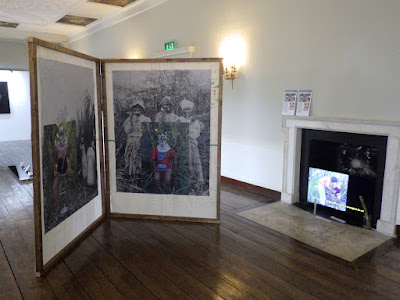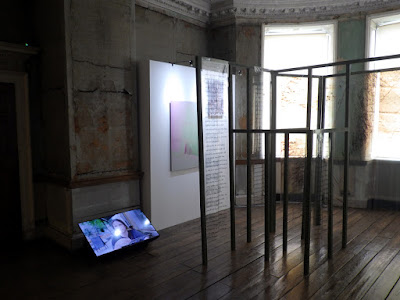A few weeks ago I went to Rathfarnham Castle to see the PhotoIreland Festival group exhibition Bite The Hand That Feeds You. In that very large space I was delighted to see that the exhibition was a smaller group show than I expected, where each artist was given ample room to stage individual installations of work around this year's themes (food consumption & human-animal relationships being the bigger ones). The first installation that one comes across (due to Covid the system of masked movement is, understandably, very particular) is by Finnish artist Hertta Kiiski. Milky Way consists of goods (cloth and clothing) that reference her video (not in the picture below) of two very bored looking teens, dressed alike and cradling large, oddly-shaped, clear bottles of milk, which they periodically drank from. There was no dialogue in the video (at least while I was watching) and the ennui was infectious, so I did not stay for the duration. I definitely had the sense of teen insecurity (in the way the bottles were cradled), boredom, and the ability to consume as something to be taken for granted. I assumed this was cow's milk as opposed to human milk and it highlights that, perhaps somewhat dubious, human-animal relationship where human's are the beneficiaries of an animal product.

In the next room one is also confronted with the treatment of animals, again cows, in the large digital data drawings of Dániel Szalai,
Unleash Your Herd's Potential. Using assorted surveillance and computer techniques, Szalai brings to the fore a number of issues concerning the human-animal relationship.
However, I have to admit, that it was the imagery and painterliness of these computer drawings that attracted me to this work.
Accompanying these works is the strange-seeming abstract floor sculpture; this, however, is a piece constructed from actual shapes of salt cow-licks and brings the element of reality into this hi-tech installation.
Sharing the room with Szalai was
Overlapping Histories, a mixed media installation by Gê Viana.
The video seems to be of the artist setting up a posed National Geographic style "authentic" cultural photograph, which is included and enlarged within the installation. There are clearly doubts about any authenticity, but also concerns about colonisation and cultural appropriation raised. While it is a thoughtful piece, I found it difficult to engage with.
Almost as an afterthought,
Tuna by Sheng-Wen Lo, was placed in the same room as these two larger installations and really seemed out of place. According to the accompanying didactic, Lo's game is concerned with sustainability and the available bottle of hand sanitizer next to the video game attested to the fact that this was a hands-on piece. However, I found nothing in its presentation to tempt me to give it a go.
The smallest room allowed for Hans van der Meer to present a video, book, and related photographs of cows together as a single entity,
Time to Change. The video, in which cows, in turns, enter a hoisting machine in order to have their hooves shorn/scaled for hygienic, health and safety purposes. The most interesting thing I found about watching this rather hypnotic process was that the cows did not in the least mind the noise (an angle grinder!) or being lifted from the ground by the machine, legs manoevred neatly in order to accommodate the human doing the work. Other sections of the video showed the cows systematically ignoring automated processes - the cows just went about their business as various machines went about theirs!
The wall of photographic portraits of these cows presents them in all their glory: ready for sale, for work (milking, procreation) or consumption (prime beef). The cows themselves do not really seem fussed at all - are they condescending or dumb?
The final, large room contained two installations.
Spinebone Soup and Stuffed Rabbits by Ksenia Yurkova is a large, multi-media humorous installation where the seemingly innocuous concept of the recipe takes on absurd dimensions. From transparent, impossible and confusing recipes hung from a complex free-standing framing system (where ingredients may include sawdust and glue) to a vox pop video, where topics include thoughts on the point/pointlessness of meat flavoured substitutes for vegetarians and vegans to the possibility of growing meat scientifically from human tissue to end world hunger. I do not know if Yurkova's video was scripted and staged or a genuine vox pop, but it most certainly provokes a reaction of ethical proportions as one tries to figure out one's own answers to some of the queries. While the overall piece delves into the absurd and comical, it has a fundamentally serious edge.
The final piece before exiting the exhibition was Alan Phelan's
A World Looted. The hexagonal pillar with light emanating from some of its planes provided a TARDIS-like curiosity seen from the corner of my eye while viewing the previous installation.
On closer inspection, those back-lights illuminated individual Joly photographs* set within the pillar. Phelan's photographs are concerned with specific global, corporate fruit controversies highlighting concerns of how fruit is produced, consumed and the ethics of globalisation and colonisation.
While the display's execution is pristine, if it weren't for the didactic and the titles of individual pieces (such as
Pineapple: let's depopulate and extract profit to make the perfect pineapple) I wouldn't have had a clue what Phelan's work was about.
*This explanation of "Joly photographs" was written on a didactic at the exhibition: This is a method of colour photography developed in the 1890s by John Joly, a physics professor at Trinity College, Dublin. It is an additive colour method, with a striped red, green and blue (RGB) colour screen placed in front of the film in-camera on exposure and then again on display. Colour information is recorded on black and white film and rendered as a colour image when the screen and film are put together. The film is processed as a positive and so what is displayed is the film that was in the camera, not a print or reproduction.













No comments:
Post a Comment